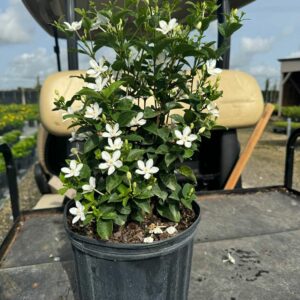Juniper Blue Pacific
Juniperus conferta ‘Blue Pacific’, commonly known as Blue Pacific juniper, is a low-growing evergreen shrub prized for its dense, spreading habit and striking blue-green foliage. It thrives in full sun to partial shade and is drought-tolerant once established. Hardy in USDA Zones 5 to 9, it excels as a ground cover, border plant, or for erosion control in various garden settings. With minimal maintenance needs and year-round visual appeal, Blue Pacific juniper is a popular choice for low-maintenance landscapes.
$36.20
Related products
-
All Products
Asian Snow Jasmine
$24.90 This product has multiple variants. The options may be chosen on the product page -
All Products
Asiatic Jasmine
$11.35 This product has multiple variants. The options may be chosen on the product page
Juniperus conferta ‘Blue Pacific’, commonly known as Blue Pacific juniper, is a low-growing evergreen shrub celebrated for its dense, spreading habit and attractive blue-green foliage. Here’s a comprehensive overview of its care, growth characteristics, landscaping uses, and additional information:
Care:
Light Requirements: Blue Pacific juniper thrives in full sun but can tolerate partial shade.
Soil: Well-draining soil is essential. It prefers sandy or loamy soils but can adapt to various soil types, including poor, rocky soils.
Watering: Once established, it is drought-tolerant and requires minimal watering. Water deeply but infrequently during hot, dry periods.
Fertilization: Generally, Blue Pacific juniper does not require fertilization if planted in nutrient-rich soil. Avoid excessive fertilization, which can lead to weak growth.
Pruning: Prune in early spring before new growth begins to maintain shape and remove any dead or damaged branches. It does not require extensive pruning.
Pests and Diseases: It is generally pest-resistant and disease-resistant, though occasional issues with spider mites or fungal diseases can occur in humid conditions.
Growth:
Size: Typically grows up to 1-2 feet tall and spreads 6-8 feet wide, making it an excellent ground cover or border plant.
Rate of Growth: Moderate growth rate.
Appearance:
Foliage: Needle-like, scale-like foliage in a striking blue-green color. The foliage is dense and covers the branches well.
Climate and Hardiness:
Hardiness Zones: Blue Pacific juniper is hardy in USDA Zones 5 to 9.
Climate: It thrives in a wide range of climates, from cool temperate to mild subtropical. It is tolerant of coastal conditions, including salt spray and wind.
Landscaping Uses:
Ground Cover: Ideal for ground cover due to its low spreading habit and dense growth.
Erosion Control: Excellent for stabilizing slopes or preventing erosion on embankments.
Borders and Edging: Creates a neat border or edging along paths, driveways, or garden beds.
Rock Gardens: Fits well in rock gardens due to its rugged appearance and drought tolerance.
Additional Information:
Cultural Significance: Blue Pacific juniper is a popular choice for its low maintenance and ability to thrive in challenging environments, including urban landscapes.
Propagation: Propagate through semi-hardwood cuttings in late summer or early autumn.
Companion Plants: Pair with other drought-tolerant plants like lavender, sedum, or ornamental grasses for a low-maintenance landscape.
Winter Interest: The blue-green foliage provides year-round interest, particularly in winter when other plants may be dormant.
In summary, Juniperus conferta ‘Blue Pacific’ is valued for its hardiness, attractive blue-green foliage, and versatility in landscaping. It requires minimal care once established and is well-suited for a variety of garden settings, from ground cover to erosion control and border planting.
| Size | 3 Gallon |
|---|



